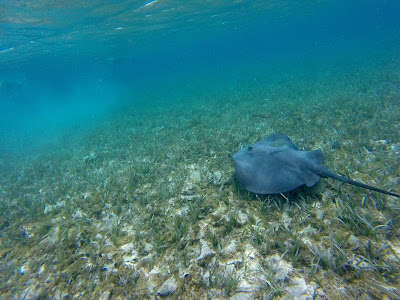Flying into the Galapagos, I quickly realized that it was nothing like I had expected.
The landscape was sparse, dry, covered in leafless trees and tree-sized cacti.
I didn’t have much in the way of expectations (I try to avoid Google image
searching places before traveling), but somehow this still defied any mental
image conjured by the word “Galapagos.”
In an effort to make a trip to the Galapagos Islands as
affordable as possible, we decided to use the two cheap tourist towns as base
camps for a quick visit. This allowed us a glimpse into the ecology of the
island system without the price tag of the multiday cruises.
Cemented in history by Darwin’s evolutionary biology
discoveries, the history of the one-time home of Lonesome George is one of
exploitation and over use of resources. Fun fact: apparently tortoise oil was
once considered a resource for use in streetlamps.
As humans have learned more about the finite nature of the
islands’ fauna (having pushed a number of species into extinction), the island
chain is now home to a plethora of sustainability and conservation efforts.
These include efforts to genetically reproduce as closely as possible the
Galapagos Tortoise (of which Lonesome George was the last, his death marking
the species’ extinction) and to grow, rather than import, as much of the
islands’ food as possible.
Seeing the ecology of the Galapagos Islands is a land, air,
and water endeavor. A full day snorkel trip (the splurge of the trip) afforded
us the opportunity to swim in surprisingly cold water with sea turtles, sharks,
and sea lions (which I’m assured are somehow different from seals), as well as
a whole rainbow’s worth of fish.
Taking advantage of the numerous free options on both Santa Cruz and San Cristobal provided the chance to see massive century-old tortoises, land iguanas with vaguely prehistoric faces, beaches filled with lounging sea lions, and birds ranging from pelicans to finches.
But, despite the full day of snorkeling and all the various museums
and conservation projects, a free hike and a dip in the frigid waters of a tiny
alcove provided the highlight of the trip. Donning rented snorkels, we
navigated the rocks at the end of the skinny, wooden pier and plunged in.
Though the fish life was moderately interesting and we soon became accustomed
to the water temperature, the snorkeling was mediocre overall.
However, we were soon joined by a group of the most curious
sea lions. Now, we swam with seals in New Zealand and on the aforementioned
snorkeling trip, but this was something else. These sea lions seemed almost to
want to play with us, zipping right up and spinning away, diving and swirling
about our feet. It was absolute magic (and it only cost $5 to rent the snorkels).
Sometimes you pay a great deal of money to observe something
unique in nature, and sometimes Mother Nature surprises you instead. Our
Galapagos adventure turned out to be a unique, interesting mixture of the two.




















































